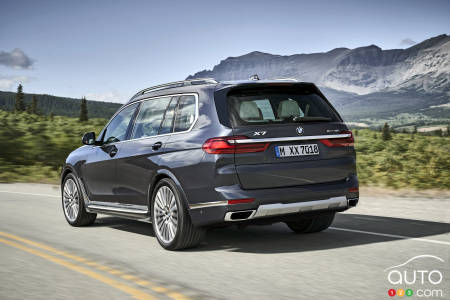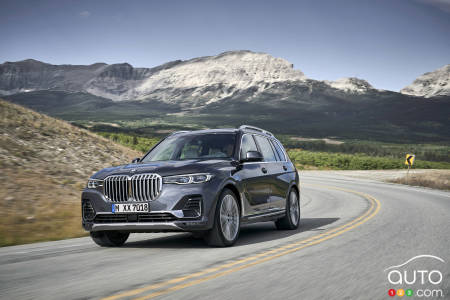The 2019 BMW X7 is the biggest vehicle the German automaker has made to date. While it’s similar in general appearance to the X5, it’s better adapted to moving big families around thanks to the three rows that make for a total capacity of seven or six occupants, depending on configuration.
BMW has corrected a lot of little flaws with this 2019 edition of the X7. And with two powerful engine setups to choose from, we’re a long ways away from a mere attempt at a luxury sport utility vehicle.
New heights of over the top
As mentioned, the X7 has much in common style-wise with the X5, except that it’s been drinking a lot of protein shakes. In any case, looking like the X5 is not exactly a drawback; this is a nice proportioned SUV, pleasant to look at and not overly boxy. The 2019 BMW X7 does more aggressively impose itself on the road, of course, which is only natural given its length (5,151 mm), width (2,000 mm) and wheelbase (3,105). This is BMW thinking big, or at least bigger than it ever has before.

BMW smartly places standard 22-inch wheels on this big guy, and other highlights include blue-tinged laser headlights and that enlarged version of the distinctive BMW double-kidney grille. Some might actually find that grille just too big, but from my vantage point it looks coherently proportioned to the mastodon that is the X7.
The interior
If you’ve ever sat in an X5, you’ll feel right at home in its bigger brother. The inside exudes quality in the materials used, and the message your five senses get is clearly that this is a luxury vehicle. A host of large and small functionalities help make life more pleasant (if sometimes more complicated!) for driver and passengers. I think for example of the heated/ventilated cup holders, five-zone climate control and the comfy pillows placed on the headrests of the second-row seats.
Some eye-catching colours are available depending on the options chosen, though I had to question the wisdom of including blue and white seats. They look great, for sure, but I wouldn’t bet on the white staying all that pure over the long haul.

In terms of options, there are a number of ways to personalize the interior via a range of options. For a touch over $600, buyers can switch out the iDrive command for one of Swarovski crystal glass, if that floats your boat. OK, we’re not exactly in the realm of essentials here, but I have to tell you that this little extra does make the already-sumptuous interior of the X7 even more so.
BMW’s intelligent personal assistant is a little gem that keeps in memory the driver’s habits and preferences in addition to functioning as a drive-assistant. Say “Hey BMW, I’m cold”, and the system automatically starts the heating system at the usual temperature. I found it simply fantastic, especially since the system gets regular updates, so its “learning” capabilities keep evolving.
Seven places for seven adults
In back, unlike in many so-called three-row people movers, you’re unlikely to draw complaints from those assigned the last row of seats. For the second row, buyers can choose between a bench, for a 7-person capacity, or captain’s chairs which turn the X7 into a 6-person vehicle.

Either way, occupants get USB ports and cup holders to their heart’s content, plus touchscreens placed on the back of the front-row seats. If you’re game for adding more options (and BMW sure does offer a lot of them), you can upgrade to a 20-speaker 1,500-watt harmon/kardon audio system that is pretty sublime.
The third row, as mentioned, is a perfectly respectable to spend time, even for those of drinking age. It helps (a lot) that the second row seats are power-movable to allow easy entry. While the third-row of the X5 is forbidden for claustrophobes to enter, this is a different environment altogether. The X7 is one of a small list of three-row SUVs that can actually keep all occupants comfortable.
The BMW X7 xDrive40i comes with active cruise control with blind spot detections, lane departure warning, rear collision alert, forward collision warning and pedestrian alert with collision attenuation. As for the xDrive 50i, it adds the Plus parking assist feature, head-up display and an active drive assist function.

Extended Traffic Jam
One of the functions I really liked is the Extended Traffic Jam feature, which in heavy traffic can take over control of the car. It’s functional at speeds of up to 50 km/h, and it uses an infrared optical camera placed in the digital dashboard to monitor the driver’s eyes and even nose position to determine if they’re dutifully paying attention to the road in front of them.
As long as they are, they don’t then have to keep their hands on the wheel (for a period of between 30 and 50 seconds). The vehicle can stop, get going again and maintain direction in its lane, without any human intervention! For having tested it out, I can tell you it makes life in traffic jams much more bearable. This is the second BMW I used this system in and I’ve found no reason to dislike it.
While the number of safety and drive assist functions is certainly impressive, less impressive to me was the new voice command system, which tends to activate at the right time and clearly still need fine-tuning. Let’s just say that with CarPlay, you might find yourself choosing to consult Siri instead.

The mechanics
The X7 can be had with one of two different engine configurations. The xDrive50i runs on a 4.4L V8 generating 456 hp and 479 lb-ft of torque, while the xDrive40i gets a 3.0L 6-cylinder engine making 335 hp and 330 lb-ft of torque.
All-wheel drive is standard on all versions of the 2019 X7; the system can equalize torque between the front and rear wheels depending on speed and the road situation.
On the road
I was surprised to find that the X7 doesn’t behave like a weighted-down X5. You don’t really feel the bulk of the vehicle behind the wheel, and I had the impression it was actually getting leaner and meaner when I pressed on the accelerator. The steering, meanwhile, is heavy and a little slow, which doesn’t lend itself to precipitous gestures.
I fully appreciated the drive modes, which definitely change the parameters and thus the performance of the X7. In Eco mode the SUV is a docile animal, while in Sport the aggression level increases noticeably.

The X7 also has an optional off-road mode, which to be honest won’ be that essential for most X7 owners who are unlikely to their costly luxury ‘ute into very difficult environments. I did find that some drivers will not like having to take their eyes off the road to change the drive modes, especially as the buttons are flat and not easy to distinguish one from the other simply by touch.
I was also mildly disappointed by the stop-start system of the engine, which isn’t the best I’ve encountered. While it made for a quiet cabin at a stop, the engine had a tendency to stop before the vehicle made a full stop, making for some rough stopping. I suspect BMW will quickly make the needed adjustment on this front.
The pricing
The xDrive 40i version of the 2019 BMX X7 starts at $92,500, and the xDrive 50i costs a minimum of $110,100. The myriad different options can quickly make those prices skyrocket, of course.

Generally, it’s my impression that BMW took careful notes of the remarks and small complaints folks had about the X5, and set out to make a more-perfected X7. The delayed introduction of the third row means that the X7 features many more functions that you’ll find in most vehicles in this format.
There’s much to appreciate in the X7, starting with the adult-friendly third row, and continuing with the dynamic drive it offers and the useful and distinct drive modes. This is a luxury vehicle that has no trouble standing out thanks to the many details it coddles occupants with, and I’ve no trouble imagining that it will crush rivals like the Cadillac Escalade and Lincoln Navigator, which come across like dinosaurs form another era in comparison!
We like
- Adult-friendly third row
- A ton of functionalities
- Power to spare and two effective engine choices
- Comfortable and easy to drive
We like less
- Forget about fitting into tight little parking spaces
- Drive mode buttons are badly designed, located
Road Tests and Reviews








